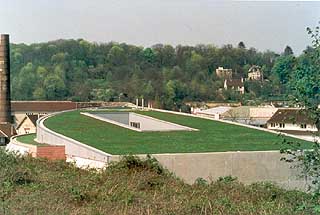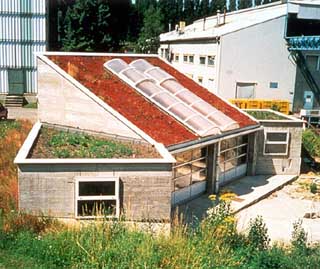|
Subscribe / Renew |
|
|
Contact Us |
|
| ► Subscribe to our Free Weekly Newsletter | |
| home | Welcome, sign in or click here to subscribe. | login |
Construction
| |

November 16, 2000
Vegetated rooftops are taking root
Journal Staff Reporter
Roofscapes Inc. is in the business of making rooftops come alive -- literally. The Philadelphia-based company specializes in transforming commercial and residential rooftops into lush, green gardens.

Photos courtesy of Soprema Inc. |
Using a green roof system called "Roofmeadow," the company waterproofs rooftops while also providing eco-friendly vegetation that changes with the seasons.
The key to Roofmeadow and other green roof systems is keeping the product lightweight and low-maintenance, according to Charlie Miller, president and founder of Roofscapes. Green roof systems can fit easily on flat or sloped roofs of up to 40 percent, and can be added to new buildings or fitted for existing structures.
Rob Bushnell, national sales rep for the France-based green roof company Soprema Inc., said the benefits of its "Sopranature" system are many-fold. "If enough of these green roofs are built in cities it can begin to help with the heat island effect, reducing the heat build-up," he said. "It also helps in terms of noise insulation."
Another benefit is the rooftops insulate against the heat during the summer. However, in the winter, the soil can freeze in certain parts of the country, reducing its insulating capability.
The green roof systems are most effective when tailored for local weather conditions, according to Miller. Engineers address critical aspects of design such as the load-bearing capacity of the underlying roof deck, moisture and root penetration resistance of the waterproofing membrane, resistance to wind shear and management of drainage. Engineers also tailor the suitability of the plants for the roof.
The vegetated roof covers are topped with foliage such as grass, herbs, succulents or wildflowers. Beneath the foliage level are a wind erosion blanket, light-weight growth medium, moisture retention fabric, waterproof membrane, leveling fabric and insulation.

|
Roofscapes' trademarked roof cover Roofmeadow can range in thickness from 2 to 6.75 inches. By modifying layer depths of the system components, the Roofmeadow system can be adapted to most climates, Miller said. The weight of the system, per square foot, ranges from 13 to 45 pounds when saturated and 8 to 30 pounds when dry.
Roofmeadow prices range from $4.50 to $20 per square foot.
As a civil engineer who previously worked in water resource management, Miller said he became excited about the roof cover system "as a solution to a lot of water resource management problems." In European countries such as Germany, Miller said green roofs address public policy issues surrounding stormwater infrastructure.
He predicted that increased pressure to improve stormwater systems in the U.S. could heighten demand for green roofs. So far, his company has three U.S. projects planned or underway, including the new Chicago City Hall. "In some ways our (regulatory) system is getting closer with Germany's, with new stormwater regulations forcing cities to take a closer look at the issue of runoff."
Bushnell said runoff containment is a major benefit of the rooftops. "With any large expanse, you get a run-off," he said. "When that water goes across a parking lot or rooftop, it picks up a lot of contaminants and that goes into your streams. If you can retain water on a roof over time, the green roof can act as a stormwater management pond. The quality of water that gets into the system is better because it's not picking up those contaminants."
But Miller added that, to have a large impact on a city's stormwater runoff quality, "you have to have enough projects clustered together. That has happened in Germany."
Tom Holz, an engineer with SCA Engineering in Lacey, said garden roofs have enormous benefits in addition to runoff attenuation. "The benefits include insulation (energy savings), sound reduction, aesthetics, clean air, urban wildlife, to name a few. My principal interest is their capacity to reduce runoff by absorbing and evapo-transpiring rainfall. This capacity makes garden rooftops a major tool in the zero-impact-development tool box."
For more arid climates, stormwater runoff is less an issue than keeping green roofs watered. For these situations, Roofscapes incorporates a "base-level" irrigation system that introduces water directly to the root zone, which reduces water losses due to evaporation.
Most systems, however, emphasize low maintenance without irrigation, Miller said. The systems are equally suited for residential, industrial and large commercial buildings. The Roofmeadow systems can be combined with a leak detection system that provides immediate notification of the smallest leak. In addition, the systems lengthen the life of rooftops by shielding them from UV rays, Miller said.
In addition to preventing water and UV damage to roofs, Bushnell said the systems have the potential to break the visual monotony of city rooftops. "Instead of looking at grungy, dirty roofs you can look at green roofs," he said.
Previous columns:
- Seattle firm focuses on keeping concrete clean, 11-09-2000
- New span bridges the past, 11-02-2000
- Constructive education, 10-26-2000
- New furniture line departs from the norm, 10-19-2000
- Green shingles may be no match for gray weather, 10-12-2000
- Builders, counties partner for green homes, 10-05-2000
- Modular construction goes to new heights, 09-28-2000
- Affordable housing to be studied at conference, 09-21-2000


